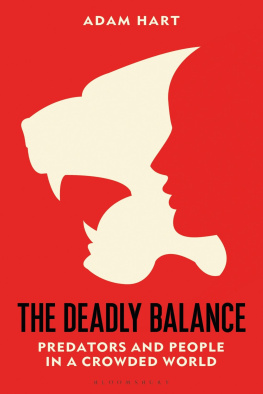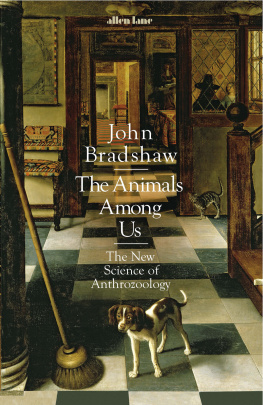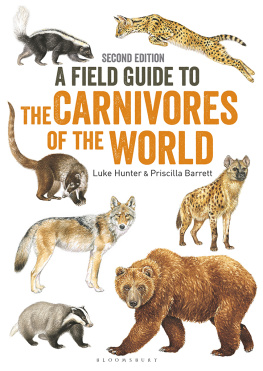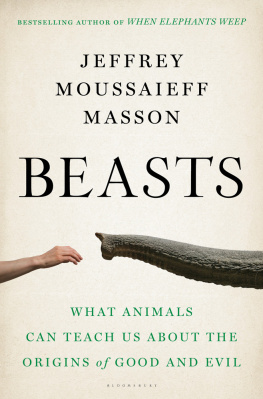Carnivore Minds

Carnivore Minds
Who These Fearsome Animals Really Are
G. A. Bradshaw

: Photo credit: Fred Buyle.
Published with assistance from the Louis Stern Memorial Fund.
Copyright 2017 by G. A. Bradshaw.
Contributions by Charlie Russell and Allan N. Schore copyright 2017 by Yale University.
All rights reserved.
This book may not be reproduced, in whole or in part, including illustrations, in any form (beyond that copying permitted by Sections 107 and 108 of the U.S. Copyright Law and except by reviewers for the public press), without written permission from the publishers.
Yale University Press books may be purchased in quantity for educational, business, or promotional use. For information, please e-mail sales.press@yale.edu (U.S. office) or sales@yaleup.co.uk (U.K. office).
Set in Adobe Garamond and Scala Sans type by Integrated Publishing Solutions.
Printed in the United States of America.
ISBN 978-0-300-21815-2 (hardcover : alk. paper)
Library of Congress Control Number: 2016952232
A catalogue record for this book is available from the British Library.
This paper meets the requirements of ANSI/NISO Z39.481992 (Permanence of Paper).
10 9 8 7 6 5 4 3 2 1
RRB, SBB, PBB, AGS, BRT, TET, TVT
Mary Watkins, an unbounded beacon
and always, JGB
Contents
by Charlie Russell
by Allan N. Schore
Giving Voice to Animals
A Naturalists Note
You should brace yourself for a measure of truth when you pick up this book. For a long time, the truth has been unwelcome and telling it, if not a revolutionary act, is, at the very least, a thankless job. We are usually navigated away from facts and then told what to think; we are managed as surely as wildlife are managed, by those Gay Bradshaw calls the privileged authority. I do not like the feeling of being managed and have always wanted to understand what is really going on in what has become a human-controlled world. Or go back and live again deep in the heart of nature, but ironically I have become dependent on a drug that keeps me alive. Because of certain health issues, I am now part of the human experiment that is based on superseding nature. Although I fear that the whole experiment is bound to fail, I would have died long ago without all sorts of clever interventions. I am thankful for my extended years, but at the same time realistic about how precarious our entire manipulated survival system is.
I have always had a home base on the land that my grandfather homesteaded 110 years ago, next to a national park in the foothills of the Alberta Rockies. Because most of my life has been spent in the same place, I have witnessed a remarkable cycle. When I was a kid, there were no wolves and virtually no coyotes, foxes, cougars, or martins, and very few bears, eagles, or hawks. I thought it was normal to be swimming among schools of white fish in the river, tripping over rabbits in the bush, finding voles under every hay bale which were chewing through the strings, and elk eating most of the winter haystack before we could feed it to the cows. There was a plentitude of herbivores, because virtually all predators had been trapped, shot, or poisoned. That was our lifestyle in those days, even in the national parks. Deer and grouse and other good-to-eat fauna were okay animalsbears and other wildlife with teeth and claws were not okay, because they were perceived as competition for humans.
Over time, this lopsided abundance began to disappear. At first, I thought that something was very wrong, and I blamed it on phenomena such as acid rain or other unintended consequences of the industrialized world. But, gradually, I realized that it was because the predators were coming back. The fur trade was losing traction, and city people from around the world were flocking to the parks to see predatorsthe bears, wolves, and osprey. All of a sudden dangerous animals had become attractive animals, because they were going extinct.
Renewed appreciation for predators plays an important role in protecting wildlife who have never been afforded protection. Nonetheless, even though public opinion has changed, and even though what science knows has changed, official rhetoric has been very slow to keep up. Park and public land managers still villainize predators. Yet everything that is said about predator dangerthat grizzlies are unpredictable, aggressive, and become more dangerous unless they are treated with hostilityis completely at odds with my experiences from seven decades of living with them up close, on a daily basis.
As long ago as the 1960s, I recognized that grizzly bears were being talked about in ways that did not make sense to me. I had limited opportunities to watch them when I was young, even though I had been raised among the few who were left after the ranchers and hunters slaughtered them without question. I began to learn more deeply about bears when my father took on a project to make the first documentary on how grizzlies lived in the wild. We had to film it in the few places left in North America, mostly in Alaska and British Columbia, where there were still grizzlies living a normal life. Disney was making films about predators, including grizzlies, who were wild, but really all the filming was done with enclosed, controlled animals.
Being my fathers camera man for three years in my twenties and wandering among grizzlies in the beauty of their habitat, I was able to observe them closely. For some reason I had a strong interest in understanding their true nature. I seemed to be able to identify with them, and what I saw vanquished any worries for my personal safety. I was able to get rid of much of the fear that had been instilled by endless stories of violence and mayhem that accompany almost every mention of grizzly bears. After spending most of my life exploring how to be able to trust grizzly bears, I am convinced that we can trust these bears implicitly. But there are far too many reasons why bears cannot, and should not, trust us.
Much later, when I was living with hundreds of bears in the wild, pristine nature of Russia for an amazing ten years, it became clear that I did not want to leave the wilderness. The world of the grizzly is a wonderful world and it lacks any of the burdensome problems of humanity. Yet I did have to venture back into civilization periodically, and the more I learned about bears, the more I wanted to find a way to apply what I had learned and put it toward something useful.
Once I understood how the real bear wanted to live, I wanted to make it plain that these animals are peace-loving, sensitive, and very intelligent, not the popular image of a blood-thirsty, horrible, unpredictable monster. It puzzled me for many years why this myth persists. Then I discovered that a lot of bad press about bears is generated by the hunting industry, which supports government wildlife agencies. The more hype about how scary an animal like a bear or wolf supposedly is, the more money can be charged for the opportunity to kill it. It is a legacy of how the system was set up in the early days of pioneering. As a result, a whole culture of fear has been built up around grizzlies.
I am excited about this book for two reasons. First, the book says in straightforward science what I have observed in Russia and Canada living among grizzlies, cougars, and other predators. Second,
Next page












